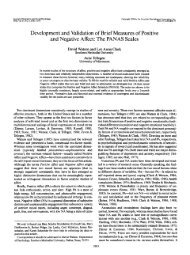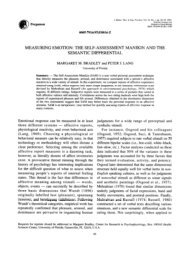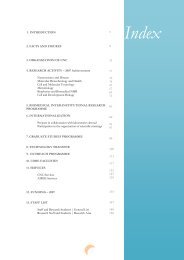Annual Report of Activities CNC 2008 - Center for Neuroscience and ...
Annual Report of Activities CNC 2008 - Center for Neuroscience and ...
Annual Report of Activities CNC 2008 - Center for Neuroscience and ...
You also want an ePaper? Increase the reach of your titles
YUMPU automatically turns print PDFs into web optimized ePapers that Google loves.
Structural <strong>and</strong> Computational Biology | Head: Rui BritoObjectivesThe group is strategically focused on the use <strong>of</strong>experimental <strong>and</strong> computational methodologies tostudy the molecular basis <strong>of</strong> human <strong>and</strong> animaldisorders, in particular amyloid diseases.Combining the reach <strong>of</strong> experimental <strong>and</strong>computational methodologies, we are working onthe characterization <strong>of</strong> the molecular speciesinvolved on the initial stages <strong>of</strong> amyloid <strong>for</strong>mationby the protein Transthyretin (TTR), the causativeagent <strong>of</strong> Familial Amyloid Polyneuropathy (FAP).Additionally, a significant ef<strong>for</strong>t is being made inthe area <strong>of</strong> virtual screening <strong>and</strong> rational design <strong>of</strong>inhibitors <strong>of</strong> TTR amyloidosis. The experiencegained with TTR is also now being used to modelinhibitors <strong>of</strong> amyloid <strong>for</strong>mation by the Aβ‐peptide<strong>of</strong> Alzheimer´s, a project in collaboration withDoctor Claudia Pereira <strong>of</strong> CNBC.Docking <strong>and</strong> Molecular Dynamics simulations in amassive parallel computer (Milipeia, UC) are beingroutinely used. Ongoing collaborations withcomputer scientists are allowing us to developtools <strong>for</strong> data mining <strong>of</strong> large data sets produced inprotein folding <strong>and</strong> unfolding computersimulations. Significant ef<strong>for</strong>ts in Grid computing<strong>and</strong> volunteer computing are being made by thegroup <strong>and</strong> in the near future will be publicized.Additionally, using time‐dependent densityfunctional theory (TDDFT) we are currentlystudying the process <strong>of</strong> light emission in theluciferin/luciferase system, present in fireflies <strong>and</strong>some beetles.Main Achievementsa. Development <strong>of</strong> the first prototype <strong>for</strong> a publicopen plat<strong>for</strong>m to share protein folding <strong>and</strong>unfolding simulations, the P‐found system(www.p‐found.org).b. Development <strong>of</strong> new data mining tools <strong>for</strong> theanalysis <strong>of</strong> multiple protein unfolding simulationsin order to infer rules that may discriminatebetween amyloidogenic <strong>and</strong> non‐amyloidogenicprotein unfolding behavior.37Fig. 1. Structural model <strong>of</strong> a potentially amyloidogenic intermediate <strong>of</strong> the protein transthyretin (TTR). (A) Ribbon representation<strong>of</strong> the subunit native structure <strong>of</strong> the amy‐loidogenic L55P‐TTR variant; (B) Partially unfolded monomer <strong>of</strong> L55P‐TTR with fullydisrupted α‐helix <strong>and</strong> fully displaced β‐str<strong>and</strong>s C <strong>and</strong> D (in orange). The residue at the mutation site is represented with greenspheres, <strong>and</strong> the unstable β‐str<strong>and</strong> H is shown in red. Partially unfolded TTR monomers have been produced by MolecularDynamics simulations in unfolding conditions, <strong>and</strong> potentially amyloidogenic intermediates have been identified by cluster analysis<strong>of</strong> thous<strong>and</strong>s <strong>of</strong> structures.






